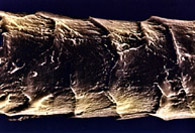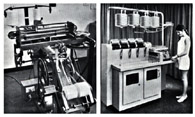
Wool technology
1957
improvements in wool production and processing by CSIRO
For a long time, the Australian economy 'rode on the sheep's back', meaning that the sale of wool was its biggest source of income. Today, wool is still a top seller, but Australians have had to develop new processes and technologies to keep it popular and price-competitive against hundreds of versatile synthetic fibres.
In the 1950s CSIRO collaborated with the Australian Wool Board to develop shrink-proof wool. The Chlorine-Hercosett process treats wool with a soft resin, then heats it. This forms a thin film over the fibre surface and prevents its protruding scales from entangling (which is what causes shrinkage of untreated wool). Villawool was the first company to commercialise the process, in 1967. Yarns are treated before they are woven into fabrics. Another shrink proofing process called Sirolan-BAP was developed by CSIRO in 1970. Garments treated using this process carry the Superwash label.
To compete with the permanent press ability of synthetic materials, CSIRO developed a process called Si-Ro-Set. This treatment chemically alters the structure of wool fibres so they can be set with heat. Si-Ro-Set was released in 1957 and is still going strong.
CSIRO has also developed new ways of spinning wool into yarn. In 1962 it improved on the traditional ?spinning Jenny?, and, in conjunction with the Australian company Repco, produced the Repco self-twist spinner. This technique made yarn production 15 times faster. In 1980, a spinning process called Sirospun was developed to spin and twist yarns in one operation. This process cut the cost of production by up to 40% in factories around the world.
Sportwool is a bi-layer fabric made from wool and polyester that was used by Australian athletes competing in the 1998 Commonwealth Games and the Sydney 2000 Olympic Games. The fabric is ideal for sportswear because it releases moisture to the outside of the garment to allow cooling during exercise, yet keeps the athlete warm before and after the sporting activity. This ?cool wool? was developed by CSIRO and The Woolmark Company and was first made commercially in 2000.
These are just a few of the many advances CSIRO has made in the production and processing of wool, from cleaning and chemical treatments to spinning and production.
Who Did It?
Key Organisations
CSIRO Division of Textile Technology : R & D
CSIRO Division of Wool Technology : R & D, design
CSIRO Textile & Fibre Technology : R & D
Australian Wool Corporation : development of shrink-proofing
Villawool Ltd : development of shrink-proofing
Repco Machinery Co : manufacture and marketing of self-twist spinner
Key People
John McPhee : researcher Si-Ro-Set; team leader shrink-proofing
Arthur Farnworth : researcher
Menzies Lipson : researcher
David Henshaw : inventor of self-twist spinner
Lionel Stern : engineer
Further Reading
Wool technology
CSIRO
CSIRO Division of Wool Technology, Geelong, 1992, pp 17-18.
Links
CSIRO Textile and Fibre Technology
Technology
in Australia 1788-1988, ATSE
The Woolmark Company
Cool
new wool -Sportwool Pro™
Sportwool™
|













